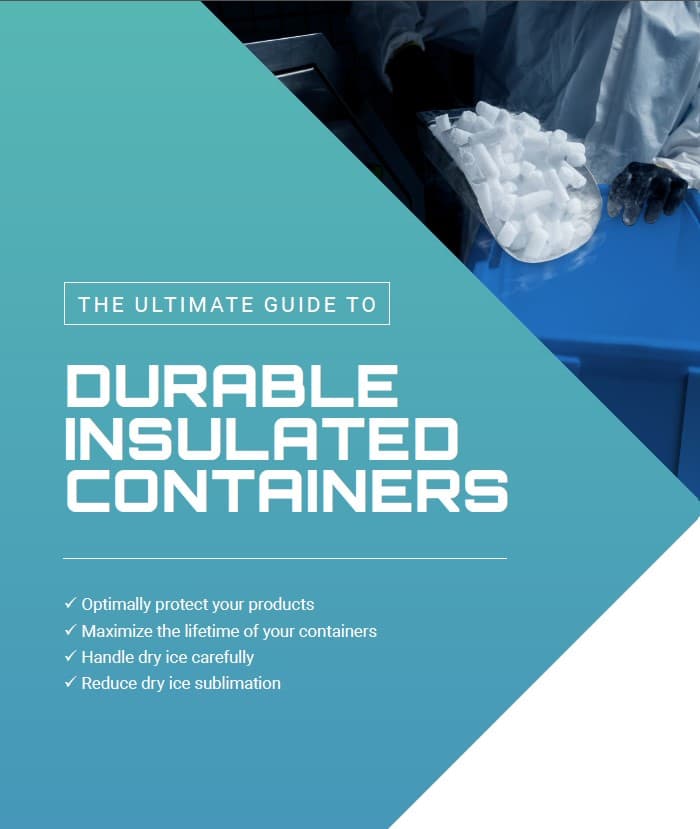Essential Best Practices for Safety, Handling and Storing Dry Ice

Dry ice, the solid form of carbon dioxide (CO₂), is widely used in various industries, from food transportation to medical applications, thanks to its ability to maintain extremely low temperatures (-78.5°C or -109.3°F) without leaving a liquid residue.
However, handling and storing dry ice requires careful attention to safety to prevent accidents and ensure effective use.
This guide explores the essential safety practices for managing dry ice, with detailed tips on using durable containers for storage and transport, alongside other important precautions.
1. Know the Risks of Dry Ice
Before diving into storage and handling practices, it’s important to recognize the risks associated with dry ice:
- Frostbite: Direct contact with dry ice can cause severe burns or frostbite due to its extremely low temperature. Even brief contact can damage skin cells.
- Asphyxiation: As dry ice sublimates, it releases CO₂ gas, which can displace oxygen in poorly ventilated areas. Prolonged exposure in confined spaces can lead to asphyxiation, posing a serious risk to health.
- Pressure Buildup: Storing dry ice in sealed, airtight containers can result in dangerous pressure buildup as CO₂ gas expands. This may lead to container rupture, creating potential hazards.
- Damage to Surfaces: The extreme cold can also damage certain materials, such as plastic or tile, making careful placement essential.
2. Using Durable Containers for Storage
Selecting the right storage container is essential for maintaining safety and prolonging the lifespan of dry ice. Follow these guidelines:
- Choose Insulated Containers: Use durable, insulated containers made of materials like Styrofoam or thick plastic to slow the sublimation process and keep the dry ice cold. These containers also prevent excessive exposure to ambient air.
- Avoid Airtight Seals: Ensure that the container is not completely sealed. Dry ice sublimates into CO₂ gas, which needs an escape route to prevent pressure buildup. Most dry ice storage containers come with vented lids for this purpose.
- Check Durability: Opt for containers that can withstand the weight and cold temperature of dry ice without cracking or breaking. Industrial-grade coolers or specially designed dry ice storage boxes are excellent choices for long-term use.
- Label the Container: Clearly label the container with “Dry Ice” and hazard warnings to alert handlers of potential risks. This is especially important when containers are shared or stored in communal areas.
- Minimize Sublimation: Keep the container closed as much as possible to limit the rate of sublimation, which can help maintain the dry ice for extended periods.
3. Safe Handling Practices
Proper handling of dry ice reduces the risk of injury or accidents. The following steps can ensure a safer experience:
- Wear Protective Gear: Always use thick, insulated gloves when handling dry ice to protect your hands from frostbite. Insulated gloves should be long enough to cover your wrists as well.
- Use Safety Goggles: Protect your eyes from potential splinters or chips of dry ice that might break off during handling. This precaution is especially important when cutting or breaking dry ice.
- Handle in Well-Ventilated Areas: Work with dry ice in spaces with good airflow to prevent CO₂ buildup and reduce the risk of asphyxiation. Ensure ventilation systems are functional if working indoors.
- Use Appropriate Tools: Use tongs or other tools to move or break apart dry ice, minimizing the risk of accidental contact. Avoid using bare hands or unprotected utensils.
- Educate Handlers: Ensure that anyone handling dry ice is trained and aware of its potential dangers.
4. Transporting Dry Ice Safely
When moving dry ice, ensure that the process is safe for both the handler and the environment:
- Use Ventilated Containers: Transport dry ice in containers that allow gas to escape while keeping the contents secure. This prevents pressure buildup and ensures safe transportation.
- Secure in Vehicles: Place the container in a stable position in your vehicle to prevent tipping or spillage. Avoid transporting large quantities of dry ice in enclosed spaces without adequate ventilation, as CO₂ gas can accumulate and displace oxygen.
- Limit Exposure Time: Minimize the time dry ice is stored in a non-ventilated area, especially in vehicles, to reduce CO₂ concentration. Long trips require additional precautions, such as periodic ventilation.
- Avoid Direct Contact with Surfaces: Place a protective layer between the dry ice container and your vehicle’s interior to prevent damage from condensation or extreme cold.
5. Disposal of Dry Ice
Proper disposal of dry ice is just as important as its storage and handling. Follow these steps to safely dispose of leftover dry ice:
- Allow Natural Sublimation: Place dry ice in a well-ventilated area, away from people, pets, and any enclosed spaces. Allow it to sublimate naturally into the air. Never leave it unattended in confined areas.
- Avoid Enclosed Disposal: Never dispose of dry ice in a sink, toilet, or trash can. The extreme cold can damage these surfaces, and the buildup of CO₂ could create a safety hazard.
- Keep Away from Combustibles: Ensure that the disposal area is free from flammable materials or heat sources that could accelerate sublimation unpredictably.
Final Thoughts
Dry ice is an incredibly useful material, but its extreme properties demand respect and caution. By understanding the hazards and following these best practices for storage, handling, and transportation, you can use dry ice safely and effectively. Always prioritize safety gear, proper ventilation, and the use of durable, non-airtight containers for a secure experience. With thorough preparation and attention to detail, dry ice can be handled efficiently without compromising safety or effectiveness.

Ultimate 101 Guide: Using Durable Insulated Containers for your Dry Ice Operations
If you’re using dry ice containers for shipping or storage, download this complete guide on everything you need to know about Durable insulated containers and chests.
Packed with critical insights and best practices, it covers safe handling of dry ice, maximizing container lifespan and minimizing dry ice loss. Whether you’re in logistics, healthcare, food service, or any cold chain operation, this guide will help protect your products, your team, and your bottom line. Don’t risk costly mistakes—master the essentials now.
Download the Ultimate Guide to get all your questions answered:
- How cold is dry ice?
- How to dispose of dry ice safely?
- How to store dry ice to minimize sublimation?
- How to select and use dry ice shipping boxes and dry ice chest?
